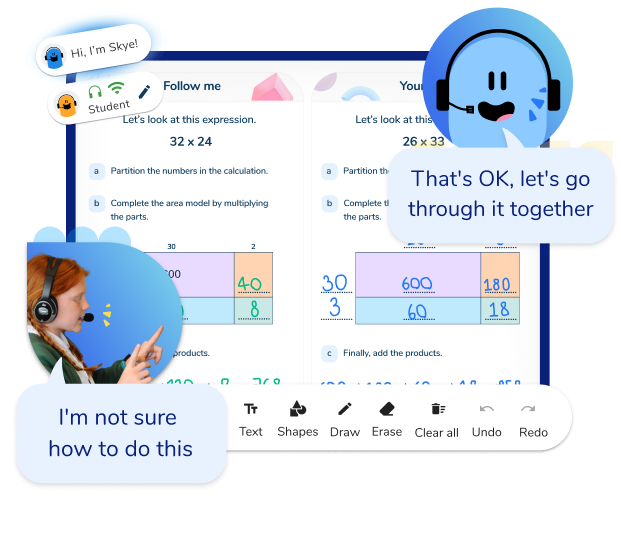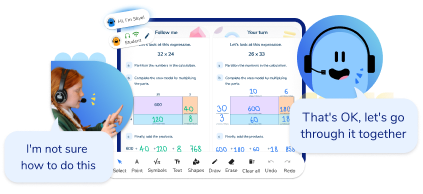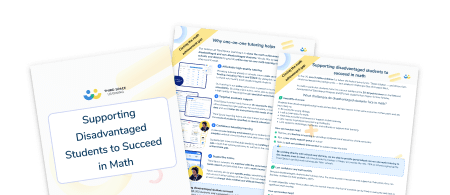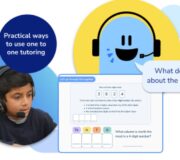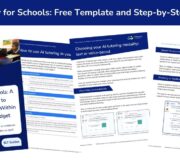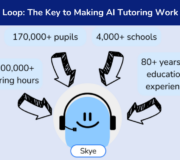How To Get The Most Out Of Tutoring For Underprivileged Students
Schools have known for a while that tutoring for students from disadvantaged backgrounds is one of the most effective measures available to narrow the academic achievement gap. However, the intensiveness of one-on-one tutoring has led people to believe it’s also one of the more costly interventions.
In fact, if seen as a return on investment in terms of progress made by students, tutoring is one of the most cost-effective interventions. But there is an initial outlay.
In this blog, we look at how you can harness the benefits of one-on-one tutoring specifically to support disadvantaged students in your school and help to close the academic achievement gap in an affordable and cost-effective way.
- Tutoring for disadvantaged students in schools
- Title 1 Funding
- ESSA Funding
- ESSER Funding
- Why the focus on disadvantaged students?
- Successful interventions for disadvantaged students
- Benefits of tutoring for disadvantaged students
- Specific challenges for disadvantaged students
- Further action we’ve taken to consider disadvantaged students
- Helping disadvantaged students succeed
Supporting Disadvantaged Students to Succeed in Math
A short guide containing practical steps for supporting disadvantaged students to succeed in math
Download Free Now!Tutoring for disadvantaged students in schools
Third Space Learning has always focused on high impact tutoring for disadvantaged students as that is where we believe the greatest need lies. However, we know schools can face budget constraints so we provide our tutoring online in order to reduce the cost to schools.
There are different funding options available that schools can use to implement targeted low or high-sage interventions for disadvantaged students, including one-on-one tutoring.
Title 1 Funding
Title 1 refers to federal financial assistance provided to schools to support educational programs that aim to improve the academic achievement of students from low-income families. It ensures economically disadvantaged children receive equity in education.
These funds can be used for interventions like tutoring, increasing disadvantaged children’s access to one-on-one math instruction.
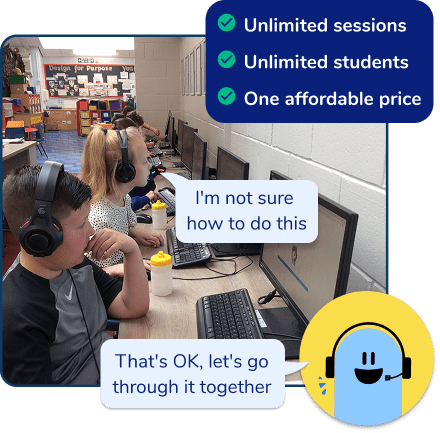
Meet Skye, the voice-based AI tutor making math success possible for every student.
Built by teachers and math experts, Skye uses the same pedagogy, curriculum and lesson structure as our traditional tutoring.
But, with more flexibility and a low cost, schools can scale online math tutoring to support every student who needs it.
Watch Skye in actionESSA Funding
ESSA encourages the use of federal funding on programs with evidence of effectiveness.
It places a significant emphasis on disadvantaged students and seeks to address educational disparities. It includes provisions that require schools to identify and support students from disadvantaged backgrounds to ensure they receive equal educational opportunities. It gives administrators and district leaders the freedom to choose which programs fit their needs.
Schools and districts can consult with their state education agency or relevant authorities to ensure that tutoring programs align with ESSA regulations and funding criteria.
ESSER Funding
Following lockdown and school closures during the coronavirus pandemic, the ESSER funding was created to provide emergency financial assistance to schools as they navigate the challenges the pandemic brought and the learning disruption it has caused.
This funding includes a focus on supporting students from disadvantaged backgrounds who have been disproportionately affected by the COVID-19 pandemic.
Among different academic support, ESSER funds can be used to provide one-on-one online tutoring services that offer targeted academic support, help students catch up on missed material, and provide additional assistance in challenging subjects.
Read more: Your School’s Tutoring Funding Options Explained
Why the focus on disadvantaged students?
Before we look at how to most effectively implement tutoring for disadvantaged students, it’s worth remembering why they need a specific approach.
A student is classified as ‘disadvantaged’ for any of the following reasons:
- Eligible for the National School Lunch Program (NSLP) within the last 12 months.
- Eligible for the School Breakfast Program (SBP) within the last 12 months.
Low family income, little or no family support and children having experienced many school moves are factors believed to have an impact on academic performance.
Successful interventions for disadvantaged students
When deciding how to spend funding, research indicates that there are 3 categories that should be considered for successful and effective interventions:
- High-quality teaching
- Targeted academic support
- A wider strategy that focuses on student’s non-academic needs such as social, behavioral and emotional needs.
Interventions that target all three of these considerations are more likely to be successful in supporting disadvantaged young people and helping to raise their academic achievement.
Supporting disadvantaged students is good for all students
Though these initiatives focus on supporting disadvantaged students, they are also beneficial to all students and can help improve schools and teaching methods, raising academic achievement across the board.
Benefits of tutoring for disadvantaged students
High-quality one-on-one tutoring offers targeted support that encapsulates the three considerations above as it focuses on the needs of each individual child.
The “High-Impact Tutoring” study by the EEF, an independent charity in the United Kingdom that aims to improve educational outcomes for disadvantaged students, found that ‘on average, one-on-one tutoring is very effective at improving students’ outcomes. One-on-one tutoring might be an effective strategy for providing targeted support for students that are identified as having low prior achievement or are struggling in particular areas. In addition, they found that a program of 10 weeks with 2-3, 30-minute one-on-one tutoring weekly sessions can add as much as five months to academic progress within the school year.
The speed of catch-up from one-on-one tutoring is particularly impactful as studies have found that students who fall behind in earlier grades have an increasingly more difficult time catching up to their peers in high school. One-one-one tutoring provides disadvantaged students with the individualized attention that they may not receive elsewhere and as such accelerates learning, improves academic performance and increases confidence.
Specific challenges for disadvantaged students
When considering introducing an intervention program for disadvantaged students, school administrators must first consider what issues impact students and what specific challenges they face.
An awareness of these issues supports the Third Space Learning math tutoring approach and helps inform our recommendations.
Confidence issues and math anxiety
Low confidence in math is a common issue among students from disadvantaged backgrounds (and all students). In a subject where there is only one definite correct answer, the fear of getting it wrong can be hard to overcome, compounding this with language hurdles (math language and potentially ESL) and participating in math class can seem extremely intimidating for young learners.
Students may experience math anxiety, a feeling of panic and helplessness when confronted by a math problem. Math anxiety can be a vicious cycle, with students performing poorly in math causing them to have anxiety and the anxiety then causing them to perform poorly.
TSL recommendation:
One of the advantages of tutoring for disadvantaged students is that you can establish a safe space where students feel that they are able to ask questions and make mistakes without fear of judgment. Look for tutors who are encouraging, reassuring and who understand the emotional component that influences performance in mathematics.
Don’t assume lower ability
Disadvantaged students are no less able than other students. Often, disadvantaged students’ parents do not have careers with academic backgrounds and children can struggle to see why they should either. This mindset can be demotivating, but a lack of motivation does not translate into a lack of ability. When disadvantaged students have the mindset and necessary support to apply themselves, they can be high achievers.
TSL recommendation:
When considering the implementation of a tutoring program, think about how you can provide a positive role model, raise students’ motivation to learn and alter their mindset around learning.
Home life
Where non-disadvantaged students may have parents to help with homework, a quiet place to do homework, a private tutor on the weekend or may be involved in other enrichment activities, home life can be more challenging for some disadvantaged students.
Many disadvantaged students’ parents may work shifts or multiple jobs, the disadvantaged student may be caring for younger siblings, lack a quiet space to study, experience instability at home or have a part-time job. In these circumstances getting one-on-one support and extra time outside of the classroom to focus on their learning is a challenge which can impact their academic performance. In addition, when a young person already has a lot of responsibilities, getting good grades may feel low on the priority list.
TSL recommendation:
Tutoring programs should aim to encourage disadvantaged students (but not pressure them) while helping them convey the value of academics and reassuring them they have what it takes to succeed.
Further action we’ve taken to consider disadvantaged students
At Third Space Learning, our chief ambition is to close the math achievement gap between disadvantaged and non-disadvantaged students and our one-on-one online tutoring is centred around this goal.
Affordability while maintaining quality
Firstly, we want our tutoring to be affordable and accessible, that’s why we implement online tutoring (rather than in person). By using online tutors we are able to decrease costs while also maintaining a high quality of teaching with well-trained and vetted tutors.
At Third Space Learning, we provide our tutoring to schools, rather than parents, making tutoring available by using school funds, including Title 1, ESSA and ESSER funding. By doing this, we make our services available to those who need it most; disadvantaged students.
Targeted academic support
In a one-on-one setting, tutors are able to tailor their instruction to the learning style of each child, something that’s simply impossible in a class of 30. Adapting instruction to the interests of an individual child can also help motivate and engage the student.
Third Space Learning tutors are also trained and advised on how to cater lessons to the needs of students with learning disabilities and special educational needs including autism, ADHD, dyslexia and more.
Targeting academic support to the specific needs of a child can help students achieve their academic goals. After each session, teachers receive a detailed report on the progress that each student is making so that they can monitor student’s progress and track their learning throughout the academic year.
Building confidence
In a one-on-one setting, math anxiety and low confidence can be mitigated as asking questions and making mistakes is no longer observed by a classroom full of peers.
Students feel more comfortable speaking up during one-on-one tutoring and receiving positive feedback in those sessions, students’ confidence grows, spilling back into the regular classroom setting and boosting the voices of disadvantaged students in the standard classroom.
Many teachers observe that disadvantaged students who take part in Third Space Learning one-on-one math instruction demonstrate more confidence in whole-class lessons and improved math talk when they tackle problems.
Student support
Students engaged in Third Space Learning online math instruction will be matched with the same tutor week on week, building a constructive, trusting relationship and providing them with a math mentor.
Tutors actively aim to give specific praise, something disadvantaged students may not receive in other aspects of their lives. This can help reassure and encourage students as well as change their mindset and attitude towards learning.
A teacher observed that Third Space Learning tutoring ‘gives students the opportunity to regularly speak to somebody and establish a relationship. The children develop their oracy as well and we have seen a change in how they speak and talk about math and their wider learning in general.’
Helping disadvantaged students succeed
At Third Space Learning, we’ve tutored over 165,000 students and supported over 3,900 schools since 2013. In the 2021/22 school year alone, we provided online tutoring to 33,839 disadvantaged students and have been delighted to see them succeed, with 90% showing deep conceptual understanding after each session and 70% of students reporting more confidence in their math skills at the end of the program.
We know how important it is to understand the challenges young people face in their learning journey and adapt to their needs. We hope that this blog has given you some helpful information that you can take with you into your school and classroom to help all of your students excel.
Further reading:
- The Nation’s Report Card (NAEP)
- Brown University Study: The Impressive Effects of Tutoring on Pre K-12 Learning: A Systematic Review and Meta-Analysis of the Experimental Evidence
- Title I funding by state
- Using ESSER and GEER funding: FAQs
- Using the American Rescue Plan Act Funding For High-Impact Tutoring
Do you have students who need extra support in math?
Give your students more opportunities to consolidate learning and practice skills through personalized math tutoring with their own dedicated online math tutor.
Each student receives differentiated instruction designed to close their individual learning gaps, and scaffolded learning ensures every student learns at the right pace. Lessons are aligned with your state’s standards and assessments, plus you’ll receive regular reports every step of the way.
Personalized one-on-one math tutoring programs are available for:
– 2nd grade tutoring
– 3rd grade tutoring
– 4th grade tutoring
– 5th grade tutoring
– 6th grade tutoring
– 7th grade tutoring
– 8th grade tutoring
Why not learn more about how it works?
Meet Skye, our AI voice tutor. Built on over a decade of tutoring expertise, Skye uses the same proven pedagogy and curriculum as our traditional tutoring to close learning gaps and accelerate progress. Watch a clip of Skye’s AI math tutoring in action.
The content in this article was originally written by UK Content Editor Vanessa Sipler and has since been revised and adapted for US schools by math curriculum specialist and former elementary math teacher Christi Kulesza.
